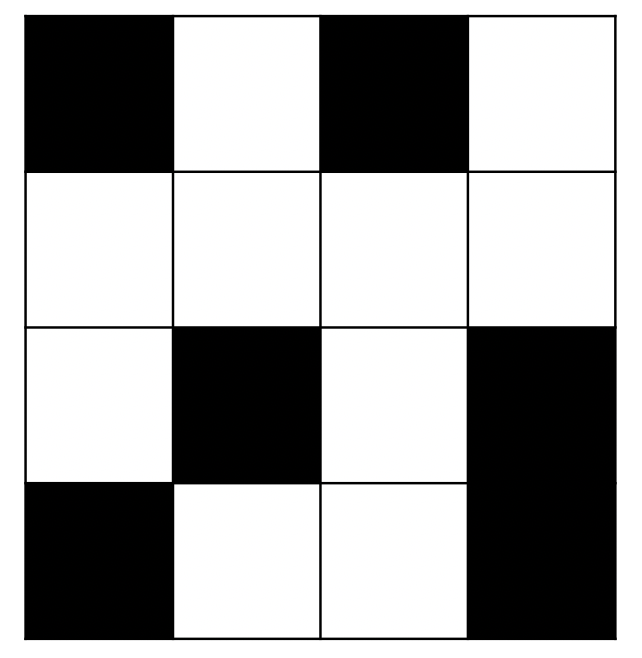需求 在4*4的图片中,比较外围黑色像素点和内圈黑色像素点个数的大小将图片分类 如上图图片外围黑色像素点5个大于内圈黑色像素点1个分为0类反之1类 想法 通过numpy、PIL构造4*4的图像
需求
在4*4的图片中,比较外围黑色像素点和内圈黑色像素点个数的大小将图片分类

如上图图片外围黑色像素点5个大于内圈黑色像素点1个分为0类反之1类
想法
- 通过numpy、PIL构造4*4的图像数据集
- 构造自己的数据集类
- 读取数据集对数据集选取减少偏斜
- cnn设计因为特征少,直接1*1卷积层
- 或者在4*4外围添加padding成6*6,设计2*2的卷积核得出3*3再接上全连接层
代码
import torch import torchvision import torchvision.transforms as transforms import numpy as np from PIL import Image
构造数据集
import csv
import collections
import os
import shutil
def buildDataset(root,dataType,dataSize):
"""构造数据集
构造的图片存到root/{dataType}Data
图片地址和标签的csv文件存到 root/{dataType}DataInfo.csv
Args:
root:str
项目目录
dataType:str
'train'或者‘test'
dataNum:int
数据大小
Returns:
"""
dataInfo = []
dataPath = f'{root}/{dataType}Data'
if not os.path.exists(dataPath):
os.makedirs(dataPath)
else:
shutil.rmtree(dataPath)
os.mkdir(dataPath)
for i in range(dataSize):
# 创建0,1 数组
imageArray=np.random.randint(0,2,(4,4))
# 计算0,1数量得到标签
allBlackNum = collections.Counter(imageArray.flatten())[0]
innerBlackNum = collections.Counter(imageArray[1:3,1:3].flatten())[0]
label = 0 if (allBlackNum-innerBlackNum)>innerBlackNum else 1
# 将图片保存
path = f'{dataPath}/{i}.jpg'
dataInfo.append([path,label])
im = Image.fromarray(np.uint8(imageArray*255))
im = im.convert('1')
im.save(path)
# 将图片地址和标签存入csv文件
filePath = f'{root}/{dataType}DataInfo.csv'
with open(filePath, 'w') as f:
writer = csv.writer(f)
writer.writerows(dataInfo)
root=r'/Users/null/Documents/PythonProject/Classifier'
构造训练数据集
buildDataset(root,'train',20000)
构造测试数据集
buildDataset(root,'test',10000)
读取数据集
class MyDataset(torch.utils.data.Dataset):
def __init__(self, root, datacsv, transform=None):
super(MyDataset, self).__init__()
with open(f'{root}/{datacsv}', 'r') as f:
imgs = []
# 读取csv信息到imgs列表
for path,label in map(lambda line:line.rstrip().split(','),f):
imgs.append((path, int(label)))
self.imgs = imgs
self.transform = transform if transform is not None else lambda x:x
def __getitem__(self, index):
path, label = self.imgs[index]
img = self.transform(Image.open(path).convert('1'))
return img, label
def __len__(self):
return len(self.imgs)
trainData=MyDataset(root = root,datacsv='trainDataInfo.csv', transform=transforms.ToTensor()) testData=MyDataset(root = root,datacsv='testDataInfo.csv', transform=transforms.ToTensor())
处理数据集使得数据集不偏斜
import itertools def chooseData(dataset,scale): # 将类别为1的排序到前面 dataset.imgs.sort(key=lambda x:x[1],reverse=True) # 获取类别1的数目 ,取scale倍的数组,得数据不那么偏斜 trueNum =collections.Counter(itertools.chain.from_iterable(dataset.imgs))[1] end = min(trueNum*scale,len(dataset)) dataset.imgs=dataset.imgs[:end] scale = 4 chooseData(trainData,scale) chooseData(testData,scale) len(trainData),len(testData) (2250, 1122)
import torch.utils.data as Data # 超参数 batchSize = 50 lr = 0.1 numEpochs = 20 trainIter = Data.DataLoader(dataset=trainData, batch_size=batchSize, shuffle=True) testIter = Data.DataLoader(dataset=testData, batch_size=batchSize)
定义模型
from torch import nn
from torch.autograd import Variable
from torch.nn import Module,Linear,Sequential,Conv2d,ReLU,ConstantPad2d
import torch.nn.functional as F
class Net(Module):
def __init__(self):
super(Net, self).__init__()
self.cnnLayers = Sequential(
# padding添加1层常数1,设定卷积核为2*2
ConstantPad2d(1, 1),
Conv2d(1, 1, kernel_size=2, stride=2,bias=True)
)
self.linearLayers = Sequential(
Linear(9, 2)
)
def forward(self, x):
x = self.cnnLayers(x)
x = x.view(x.shape[0], -1)
x = self.linearLayers(x)
return x
class Net2(Module):
def __init__(self):
super(Net2, self).__init__()
self.cnnLayers = Sequential(
Conv2d(1, 1, kernel_size=1, stride=1,bias=True)
)
self.linearLayers = Sequential(
ReLU(),
Linear(16, 2)
)
def forward(self, x):
x = self.cnnLayers(x)
x = x.view(x.shape[0], -1)
x = self.linearLayers(x)
return x
定义损失函数
# 交叉熵损失函数 loss = nn.CrossEntropyLoss() loss2 = nn.CrossEntropyLoss()
定义优化算法
net = Net() optimizer = torch.optim.SGD(net.parameters(),lr = lr)
net2 = Net2() optimizer2 = torch.optim.SGD(net2.parameters(),lr = lr)
训练模型
# 计算准确率
def evaluateAccuracy(dataIter, net):
accSum, n = 0.0, 0
with torch.no_grad():
for X, y in dataIter:
accSum += (net(X).argmax(dim=1) == y).float().sum().item()
n += y.shape[0]
return accSum / n
def train(net, trainIter, testIter, loss, numEpochs, batchSize,
optimizer):
for epoch in range(numEpochs):
trainLossSum, trainAccSum, n = 0.0, 0.0, 0
for X,y in trainIter:
yHat = net(X)
l = loss(yHat,y).sum()
optimizer.zero_grad()
l.backward()
optimizer.step()
# 计算训练准确度和loss
trainLossSum += l.item()
trainAccSum += (yHat.argmax(dim=1) == y).sum().item()
n += y.shape[0]
# 评估测试准确度
testAcc = evaluateAccuracy(testIter, net)
print('epoch {:d}, loss {:.4f}, train acc {:.3f}, test acc {:.3f}'.format(epoch + 1, trainLossSum / n, trainAccSum / n, testAcc))
Net模型训练
train(net, trainIter, testIter, loss, numEpochs, batchSize,optimizer) epoch 1, loss 0.0128, train acc 0.667, test acc 0.667 epoch 2, loss 0.0118, train acc 0.683, test acc 0.760 epoch 3, loss 0.0104, train acc 0.742, test acc 0.807 epoch 4, loss 0.0093, train acc 0.769, test acc 0.772 epoch 5, loss 0.0085, train acc 0.797, test acc 0.745 epoch 6, loss 0.0084, train acc 0.798, test acc 0.807 epoch 7, loss 0.0082, train acc 0.804, test acc 0.816 epoch 8, loss 0.0078, train acc 0.816, test acc 0.812 epoch 9, loss 0.0077, train acc 0.818, test acc 0.817 epoch 10, loss 0.0074, train acc 0.824, test acc 0.826 epoch 11, loss 0.0072, train acc 0.836, test acc 0.819 epoch 12, loss 0.0075, train acc 0.823, test acc 0.829 epoch 13, loss 0.0071, train acc 0.839, test acc 0.797 epoch 14, loss 0.0067, train acc 0.849, test acc 0.824 epoch 15, loss 0.0069, train acc 0.848, test acc 0.843 epoch 16, loss 0.0064, train acc 0.864, test acc 0.851 epoch 17, loss 0.0062, train acc 0.867, test acc 0.780 epoch 18, loss 0.0060, train acc 0.871, test acc 0.864 epoch 19, loss 0.0057, train acc 0.881, test acc 0.890 epoch 20, loss 0.0055, train acc 0.885, test acc 0.897
Net2模型训练
# batchSize = 50 # lr = 0.1 # numEpochs = 15 下得出的结果 train(net2, trainIter, testIter, loss2, numEpochs, batchSize,optimizer2) epoch 1, loss 0.0119, train acc 0.638, test acc 0.676 epoch 2, loss 0.0079, train acc 0.823, test acc 0.986 epoch 3, loss 0.0046, train acc 0.987, test acc 0.977 epoch 4, loss 0.0030, train acc 0.983, test acc 0.973 epoch 5, loss 0.0023, train acc 0.981, test acc 0.976 epoch 6, loss 0.0019, train acc 0.980, test acc 0.988 epoch 7, loss 0.0016, train acc 0.984, test acc 0.984 epoch 8, loss 0.0014, train acc 0.985, test acc 0.986 epoch 9, loss 0.0013, train acc 0.987, test acc 0.992 epoch 10, loss 0.0011, train acc 0.989, test acc 0.993 epoch 11, loss 0.0010, train acc 0.989, test acc 0.996 epoch 12, loss 0.0010, train acc 0.992, test acc 0.994 epoch 13, loss 0.0009, train acc 0.993, test acc 0.994 epoch 14, loss 0.0008, train acc 0.995, test acc 0.996 epoch 15, loss 0.0008, train acc 0.994, test acc 0.998
测试
test = torch.Tensor([[[[0,0,0,0],[0,1,1,0],[0,1,1,0],[0,0,0,0]]],
[[[1,1,1,1],[1,0,0,1],[1,0,0,1],[1,1,1,1]]],
[[[0,1,0,1],[1,0,0,1],[1,0,0,1],[0,0,0,1]]],
[[[0,1,1,1],[1,0,0,1],[1,0,0,1],[0,0,0,1]]],
[[[0,0,1,1],[1,0,0,1],[1,0,0,1],[1,0,1,0]]],
[[[0,0,1,0],[0,1,0,1],[0,0,1,1],[1,0,1,0]]],
[[[1,1,1,0],[1,0,0,1],[1,0,1,1],[1,0,1,1]]]
])
target=torch.Tensor([0,1,0,1,1,0,1])
test
tensor([[[[0., 0., 0., 0.],
[0., 1., 1., 0.],
[0., 1., 1., 0.],
[0., 0., 0., 0.]]],
[[[1., 1., 1., 1.],
[1., 0., 0., 1.],
[1., 0., 0., 1.],
[1., 1., 1., 1.]]],
[[[0., 1., 0., 1.],
[1., 0., 0., 1.],
[1., 0., 0., 1.],
[0., 0., 0., 1.]]],
[[[0., 1., 1., 1.],
[1., 0., 0., 1.],
[1., 0., 0., 1.],
[0., 0., 0., 1.]]],
[[[0., 0., 1., 1.],
[1., 0., 0., 1.],
[1., 0., 0., 1.],
[1., 0., 1., 0.]]],
[[[0., 0., 1., 0.],
[0., 1., 0., 1.],
[0., 0., 1., 1.],
[1., 0., 1., 0.]]],
[[[1., 1., 1., 0.],
[1., 0., 0., 1.],
[1., 0., 1., 1.],
[1., 0., 1., 1.]]]])
with torch.no_grad():
output = net(test)
output2 = net2(test)
predictions =output.argmax(dim=1)
predictions2 =output2.argmax(dim=1)
# 比较结果
print(f'Net测试结果{predictions.eq(target)}')
print(f'Net2测试结果{predictions2.eq(target)}')
Net测试结果tensor([ True, True, False, True, True, True, True])
Net2测试结果tensor([False, True, False, True, True, False, True])
到此这篇关于Pytorch 使用CNN图像分类的实现的文章就介绍到这了,更多相关Pytorch CNN图像分类内容请搜索易盾网络以前的文章或继续浏览下面的相关文章希望大家以后多多支持易盾网络!
